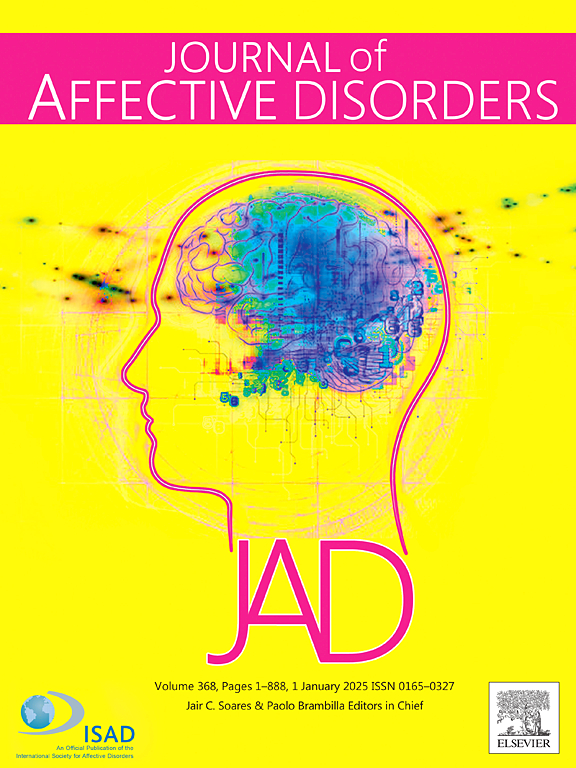共变灰质和白质网络在连续体上表征精神分裂症和双相情感障碍:数据融合机器学习方法和脑网络分析。
IF 4.9
2区 医学
Q1 CLINICAL NEUROLOGY
引用次数: 0
摘要
精神分裂症(SZ)和双相情感障碍(BD)共享遗传和大脑异常,支持扩展连续体假说。在本文中,我们旨在更好地表征SZ和BD之间灰质和白质特征的差异和共性,以阐明它们如何在这个连续体上对齐或分化。我们将数据融合技术独立向量分析(tIVA)转置到128例SZ患者、128例BD患者和127例健康对照(CTRL)的灰质和白质图像中,这些人的性别、年龄和智商相匹配。在检测到的18个tIVA网络中,SZ和BD之间有3个不同(tIV9,14,15),主要涉及额颞区。这些相同的网络加上另外两个(tiv3,4),在SZ和CTRL之间存在差异,表明存在更大的折衷,而在BD和对照组之间只有一个网络(tIV9)存在差异。总的来说,SZ在程度和严重程度上表现出更明显的GM-WM异常。BD处于中间位置。值得注意的是,在所有三组(SZ、BD和CTRL)中有一个网络是不同的。随机森林分类证实了这些结果,表明tIV9是区分三组的主要预测因子。此外,为了了解三组网络之间的最终差异,进行了网络分析。SZ个体的聚类系数和密度与CTRL显著不同。而双相障碍个体与对照组的比较无明显差异。这项研究为扩展连续统假说提供了新的亮点,根据该假说,精神分裂症和双相情感障碍患者处于相同的神经异常连续统上。本文章由计算机程序翻译,如有差异,请以英文原文为准。
Covarying gray and white matter networks characterize schizophrenia and bipolar disorders on a continuum: A data fusion machine learning approach and a brain network analysis
Schizophrenia (SZ) and Bipolar disorder (BD) share genetic and cerebral abnormalities, supporting an expanded continuum hypothesis. In this paper, we aim to better characterize differences and commonalities of gray and white matter features between SZ and BD to clarify how they align or diverge on this continuum. We transposed independent vector analysis (tIVA), a data fusion technique, to the gray and white matter images of 128 individuals diagnosed with SZ, 128 with BD and 127 healthy controls (CTRL), matched for gender, age and IQ. Of the 18 tIVA networks detected, three differed between SZ and BD (tIV9,14,15), primarily involving fronto-temporal regions. These same networks plus two more (tIV3,4), differed between SZ and CTRL indicating a larger compromission, whereas only one network (tIV9) differed between BD and controls. Overall, SZ displayed the more pronounced GM-WM abnormalities in both extent and severity with BD lying in an intermediate position. Of note, one network differed among all three groups (SZ, BD, and CTRL). Random forest classification confirmed these results by indicating the tIV9 as the main predictors that separate the three groups. Moreover, to appreciate eventual differences between networks across the three groups a network analyses was performed. Individuals with SZ demonstrated a significantly different clustering coefficient and density compared to CTRL. While the comparison between individuals with BD and controls did not show marked differences. This study sheds new lights on the expanded continuum hypothesis according to which individuals with schizophrenia and bipolar disorder lay on the same continuum of neurological abnormalities.
求助全文
通过发布文献求助,成功后即可免费获取论文全文。
去求助
来源期刊

Journal of affective disorders
医学-精神病学
CiteScore
10.90
自引率
6.10%
发文量
1319
审稿时长
9.3 weeks
期刊介绍:
The Journal of Affective Disorders publishes papers concerned with affective disorders in the widest sense: depression, mania, mood spectrum, emotions and personality, anxiety and stress. It is interdisciplinary and aims to bring together different approaches for a diverse readership. Top quality papers will be accepted dealing with any aspect of affective disorders, including neuroimaging, cognitive neurosciences, genetics, molecular biology, experimental and clinical neurosciences, pharmacology, neuroimmunoendocrinology, intervention and treatment trials.
 求助内容:
求助内容: 应助结果提醒方式:
应助结果提醒方式:


